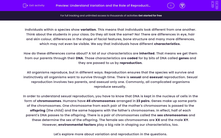Individuals within a species show variation. This means that individuals look different from one another. Think about the students in your class. Do they all look the same? No! There are differences in eye, hair and skin colour, differences in the shape of facial features, bone structure and many more differences, which may not even be visible. We say that individuals have different characteristics.
How do these differences come about? A lot of our characteristics are inherited. That means we get them from our parents through their DNA. Those characteristics are coded for by bits of DNA called genes and they are passed to us by reproduction.
All organisms reproduce, but in different ways. Reproduction ensures that the species will survive and instinctively all organisms want to survive through time. There is sexual and asexual reproduction. Sexual reproduction involves two parents, and asexual only one. Commonly, all complicated organisms reproduce sexually.
In order to understand sexual reproduction, you have to know that DNA is kept in the nucleus of cells in the form of chromosomes. Humans have 46 chromosomes arranged in 23 pairs. Genes make up some parts of the chromosomes. One chromosome from each pair of the mother's chromosomes is passed to the offspring (the child) and the same happens with the father's chromosomes. In effect, half of each parent's DNA passes to the offspring. There is a pair of chromosomes called the sex chromosomes and these determine the sex of the offspring. The female sex chromosomes are XX and the male XY.
However, environmental factors play a big role in shaping our characteristics, too.
Let's explore more about variation and reproduction in the questions.








